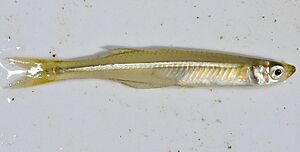Inland silverside facts for kids
Quick facts for kids Inland silverside |
|
|---|---|
 |
|
| Conservation status | |
| Scientific classification | |
| Synonyms | |
|
The inland silverside (Menidia beryllina) is a small, shiny fish. It is originally from eastern North America. This fish has also been brought to California. Inland silversides live in places where fresh water meets salty water, like estuaries. They also live in freshwater environments.
Contents
What Does the Inland Silverside Look Like?
Inland silversides are long and thin. They are about six to seven times longer than they are deep. They have big eyes and a mouth that points slightly upwards. The top of their head is quite flat.
They have two dorsal fins on their back. The front fin is small with a few soft spines. The back fin is larger with one spine and several rays. Their long anal fin is shaped a bit like a hook.
As their name suggests, their sides are very silvery. Their back is a bit yellow, and their belly is a see-through green. These fish are usually small. Most adults are 10 cm (about 4 inches) or less. Some have been recorded up to 15 cm (about 6 inches).
What Do Inland Silversides Eat?
These fish mostly eat tiny water creatures called zooplankton. They swim in huge groups, called schools. These schools can eat a lot of the small bugs and crustaceans they like.
Inland silversides are also food for many other animals. Different kinds of fish and birds hunt them. The silversides often gather in shallow water. They like sandy or gravelly bottoms, especially with cover above them. Then, they move into open water to find more food. This makes them more likely to be eaten by predators. Because of this, they often move around in a daily pattern.
Where Do Inland Silversides Live?
We don't know the exact original home of the inland silverside. They are found all along the Atlantic coast. This stretches from Maine down to Florida. They also live along the Gulf of Mexico.
In the Mississippi River, you can find them far inland. They live in calm waters and lakes as far north as Missouri and Illinois. This is hundreds of miles from the ocean.
Inland Silversides in California
Inland silversides were brought to Clear Lake in California in 1967. They were also put into the Blue Lakes. The idea was to help control tiny insects like the Clear Lake gnat and midges. The next year, they were put into lakes and reservoirs in Alameda County and Santa Clara County.
From there, they spread into the San Francisco Bay and the Central Valley. Now, they are common in central California. In some places, they are the most common type of fish. Some people think these fish might have caused problems for other native fish, like the Clear Lake splittail. However, scientists are still studying how these silversides affect California's natural areas.
How Clean Water Affects Inland Silversides
Inland silversides are very sensitive to dirty water. They are often used by scientists to check how healthy a river or bay is. This is because they react badly to pollution from things like stormwater and heavy metals.
Studies have shown that even a small amount of pollution can harm them. For example, dirty water can cause problems for their eggs and baby fish. These problems include:
- Spinal curves
- Smaller body size
- Different eye sizes
Pollutants like cadmium, chromium, and copper can also cause issues. They can make the fish's swim bladder swell up too much. This makes it hard for them to swim and float properly. If they can't swim well, they can't find food. This can lead to many fish dying. Inland silversides show problems at much lower pollution levels than other fish. This shows how sensitive they are to chemicals and heavy metals in the water.
Fungus and Inland Silversides
Inland silverside eggs can also be harmed by certain types of fungus. One example is Beaveria bassiana. This fungus is sometimes used to control farm pests. It usually doesn't hurt animals with backbones.
However, this fungus can harm inland silverside embryos (developing eggs). It can make the eggs die. The fungus releases special chemicals that break down the outer layer of the egg. When this layer breaks, the embryo dies quickly. This shows that inland silversides are very sensitive to foreign substances, even tiny living things like fungi.
Inland Silverside Reproduction
Inland silversides have different ways of laying eggs depending on where they live. In the northern parts of their home, they usually lay eggs once a year. This happens between May and July. In the southern areas, they might lay eggs twice a year. This often happens in the spring and again in early fall.
Water temperature is very important for them to lay eggs. They start laying eggs when the water is between 13.5 and 17.0 °C (56.3 and 62.6 °F). They stop when the water gets warmer, between 27.0 to 32.4 °C (80.6 to 90.3 °F).
Many groups of these fish, especially in Texas and Florida, have a special way of reproducing. They produce a lot of offspring (babies). However, they don't take care of their young at all. They also grow up and can have babies very quickly when they are young.
Female inland silversides grow faster than males. Young females can grow about 0.31 to 0.34 millimeters per day. Young males grow a bit slower, about 0.20 to 0.27 millimeters per day.


